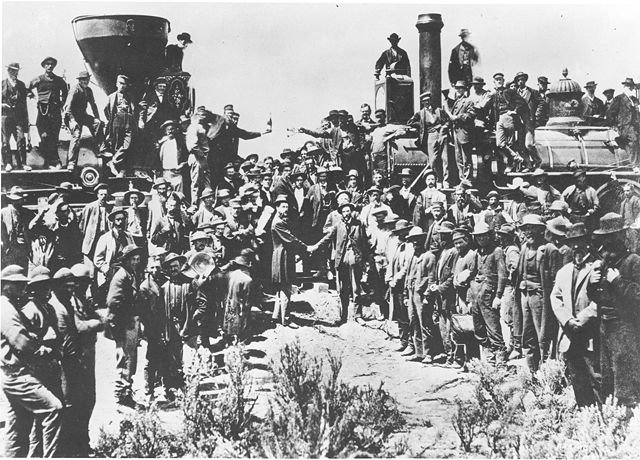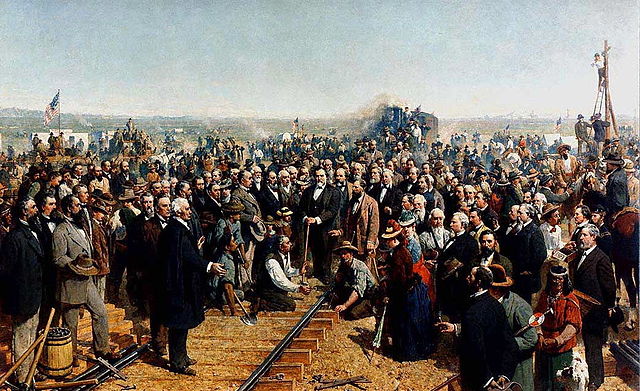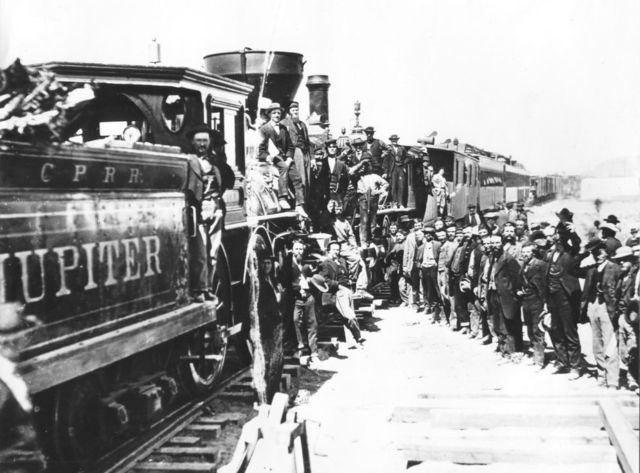Railroad "Done"
Today, the railroad is "Done". The University of Houston's College of Engineering presents this series about the machines that make our civilization run, and the people whose ingenuity created them.

On May 10, 1869 at center left, Samuel S. Montague (Central Pacific Railroad) shakes hands with Grenville M. Dodge (Union Pacific Railroad), center right [Wikipedia image]
It's May 10th, 1869. The entire nation is awaiting the completion of the American transcontinental railroad. The final moments are being telegraphed LIVE. Click, Click, Click ... The hammer strikes the final spike. Each strike is followed by a telegraph transmission. A six-year project is about to come to an end.
The American transcontinental railroad is one of the greatest technological achievements of the 19th century. The railroad connected eastern states to western states. It reduced travel time from 6 months to 6 days.

The Last Spike by Thomas Hill (1881) [Wikipedia image]
The railroad workers mostly consisted of Chinese immigrants, Irish, African-Americans and army veterans. Many books, movies and TV series have described this seemingly impossible ordeal. An AMC TV series called "Hell on Wheels" brought to life these temporary towns made of tents with harsh or 'hellish' living conditions. The towns moved from location to location on wheels.

Ceremonial "Golden Spike"
[Wikipedia image]
Although it was post civil war era, peace was not necessarily in sight. The railroad workers were occasionally attacked by robbers or competitors sent to sabotage the railroad, or native Indians defending their land. The wildness of nature intersected with the technology and civilization brought on wheels.
The workers and supervisor's daytime clothing, some with knives and guns, reflected the harshness and dangers of the living and working conditions at those locations. Occasional properly dressed formal table dining on the train hinted on the advanced civilization where they came from. It was a game of contradictions and diversities.
Telegraph played an important role in all of this. It provided the ability to communicate, especially urgent messages, like: "We are under attack STOP Send help STOP."
Perhaps the most memorable are the last moments of the railroad completion transmitted through telegraph. The whole nation experienced the strikes on the final "Golden" spike LIVE. Upon the final strike, a last telegraphic signal was sent. It was very short ... a one-word message: "DONE."
I'm Haleh Ardebili at the University of Houston, where we're interested in the way inventive minds work.
At the ceremony for the driving of the "Last Spike" at Promontory Summit, Utah, May 10, 1869. [Wikipedia image from the NPS website at https://www.nps.gov/gosp/index.htm]
Reference:
Stephen E. Ambrose, Nothing Like It In the World: The Men Who Built the Transcontinental Railroad 1863-1869, Simon & Schuster, 2001.
David Haward Bain, Empire Express: Building the First Transcontinental Railroad, Penguin Books, 2000.
TV Series 'Hell on Wheels' premiered on AMC channel on Nov 6, 2011.
This episode was first aired on November 28, 2012.
